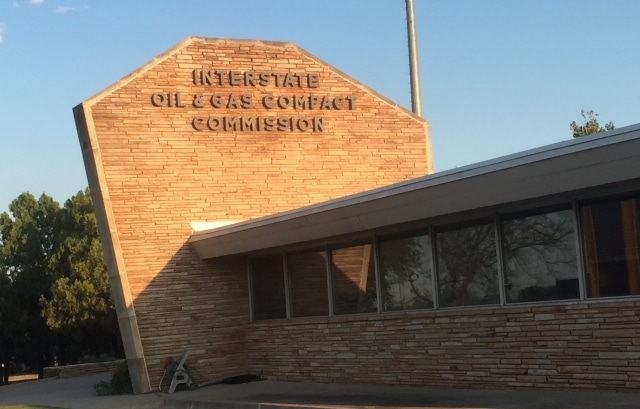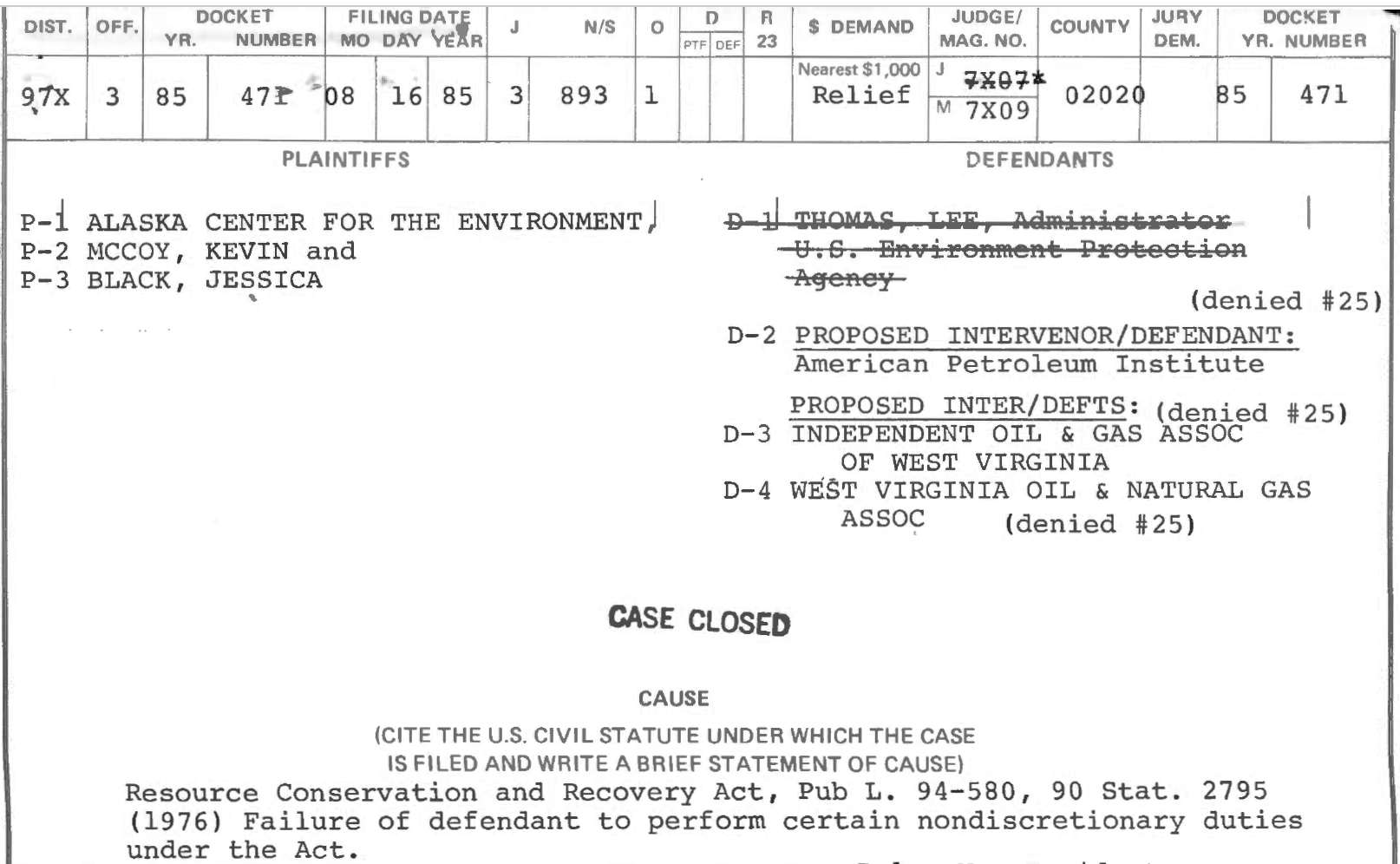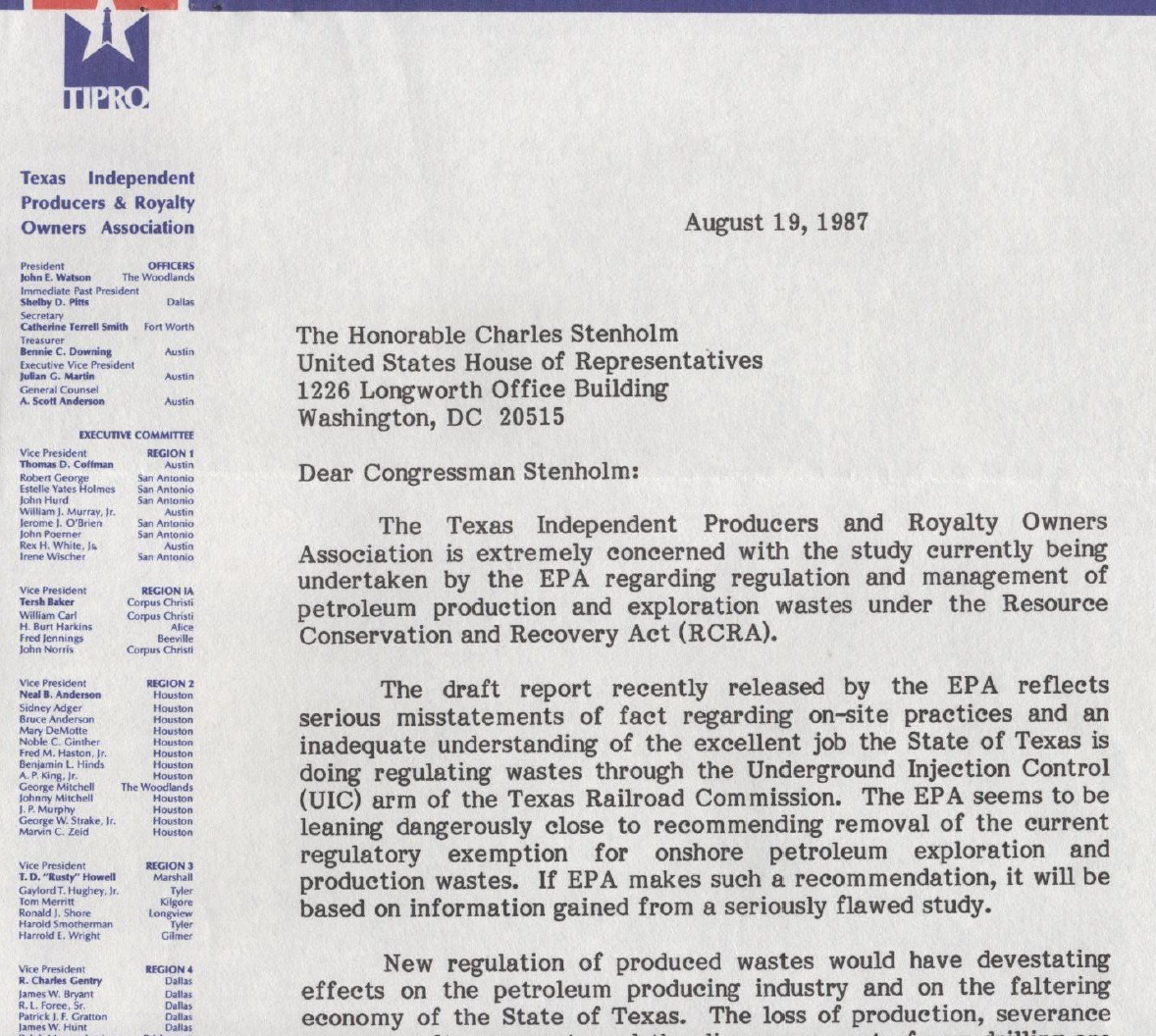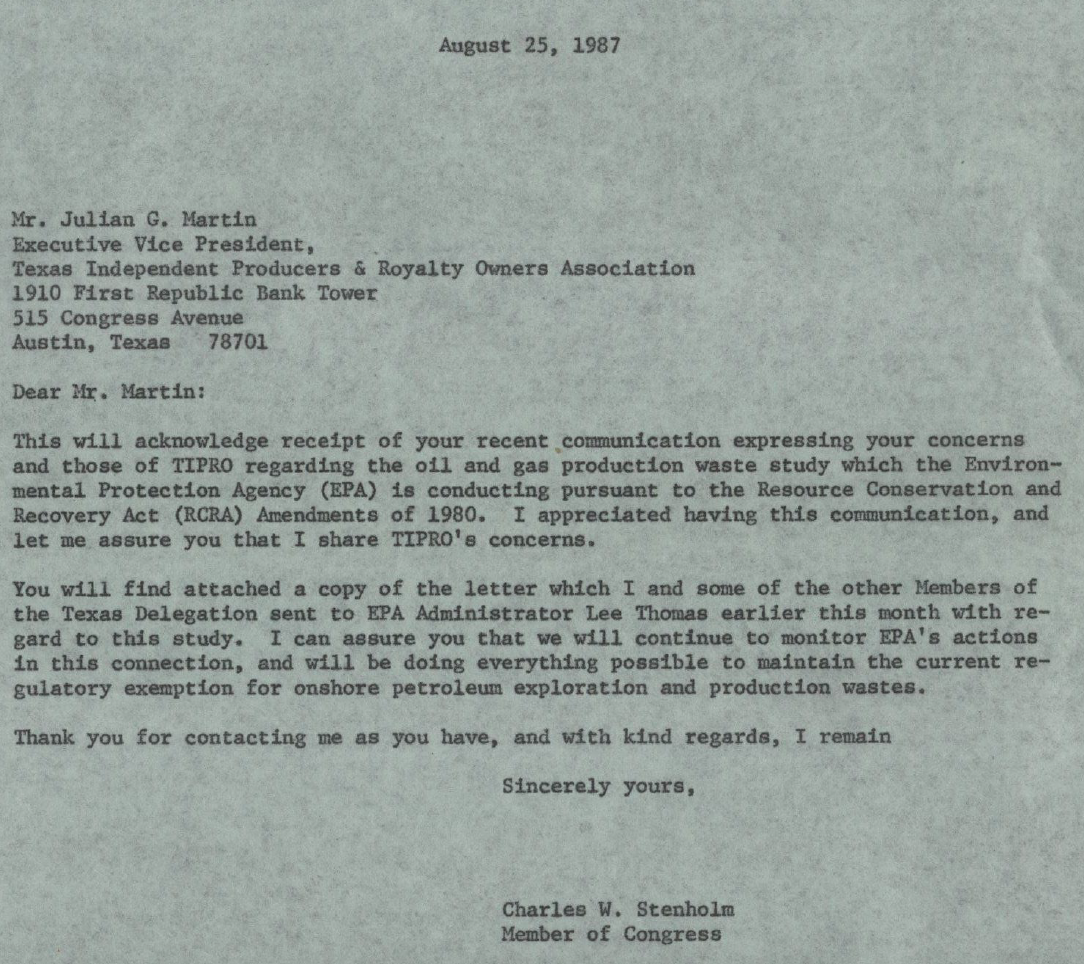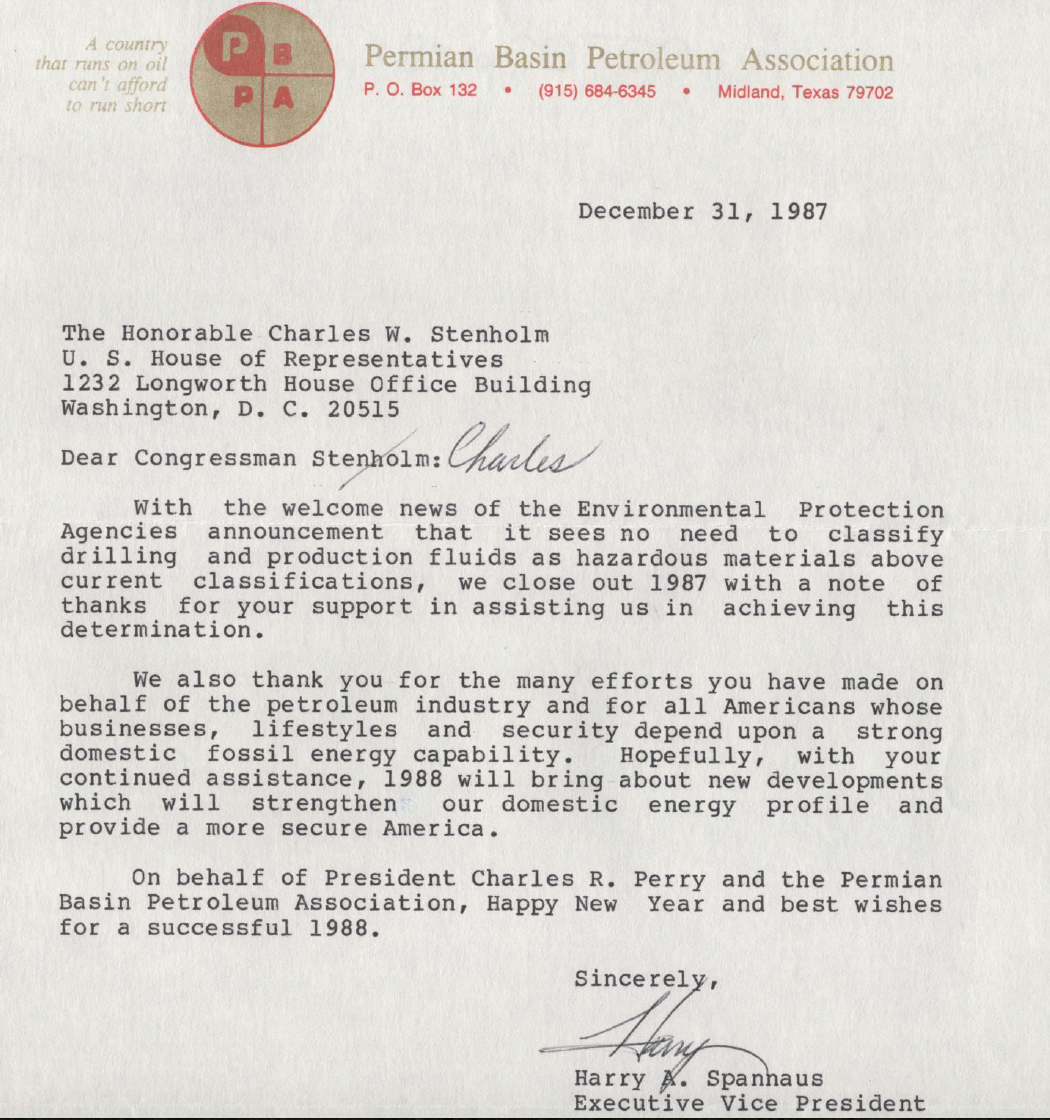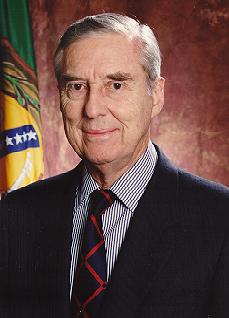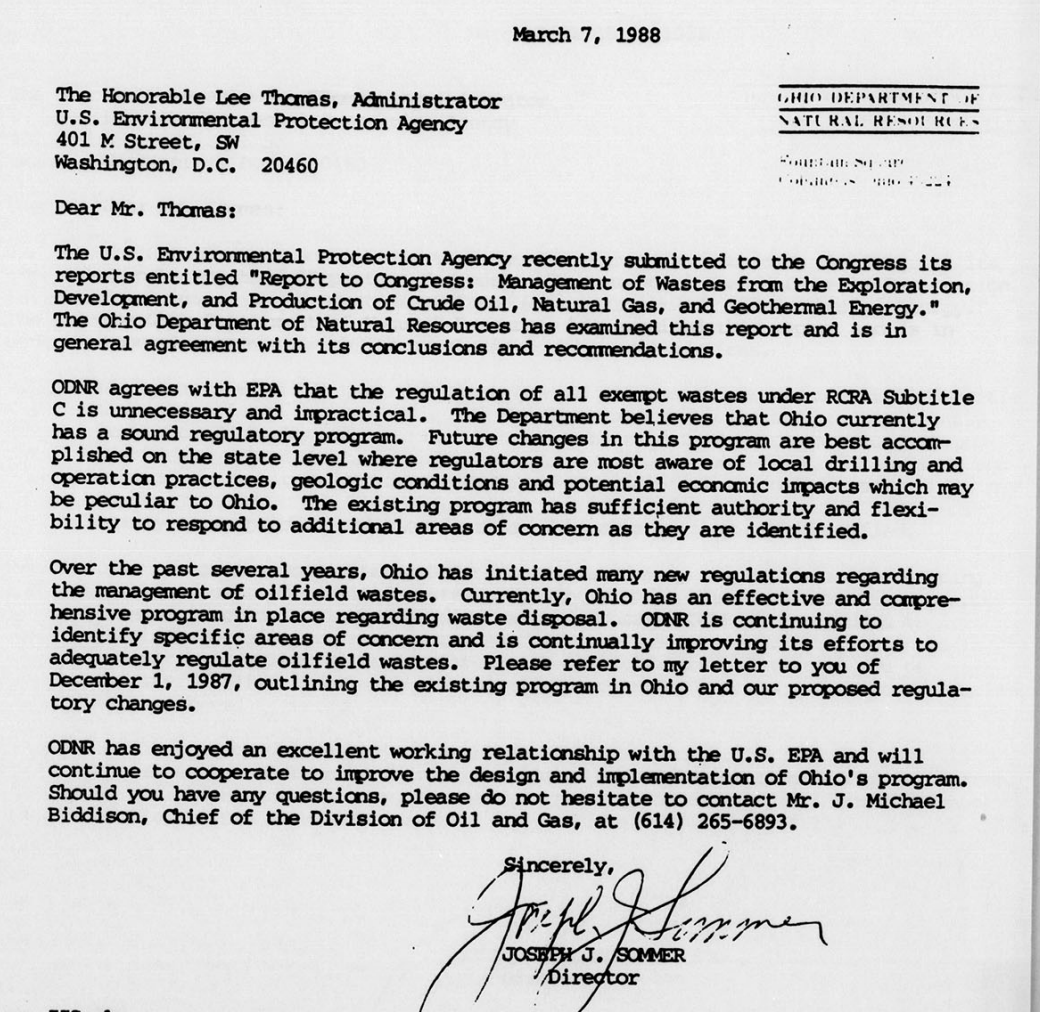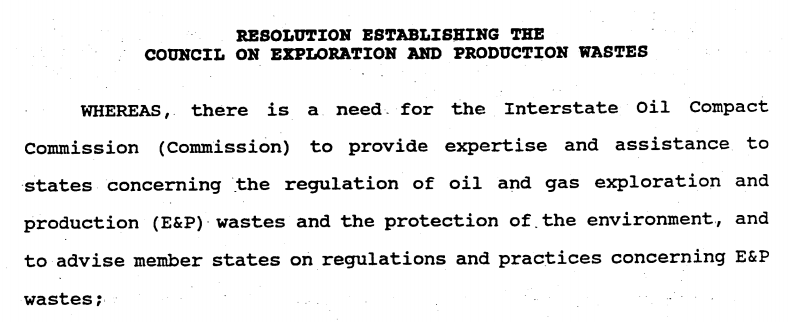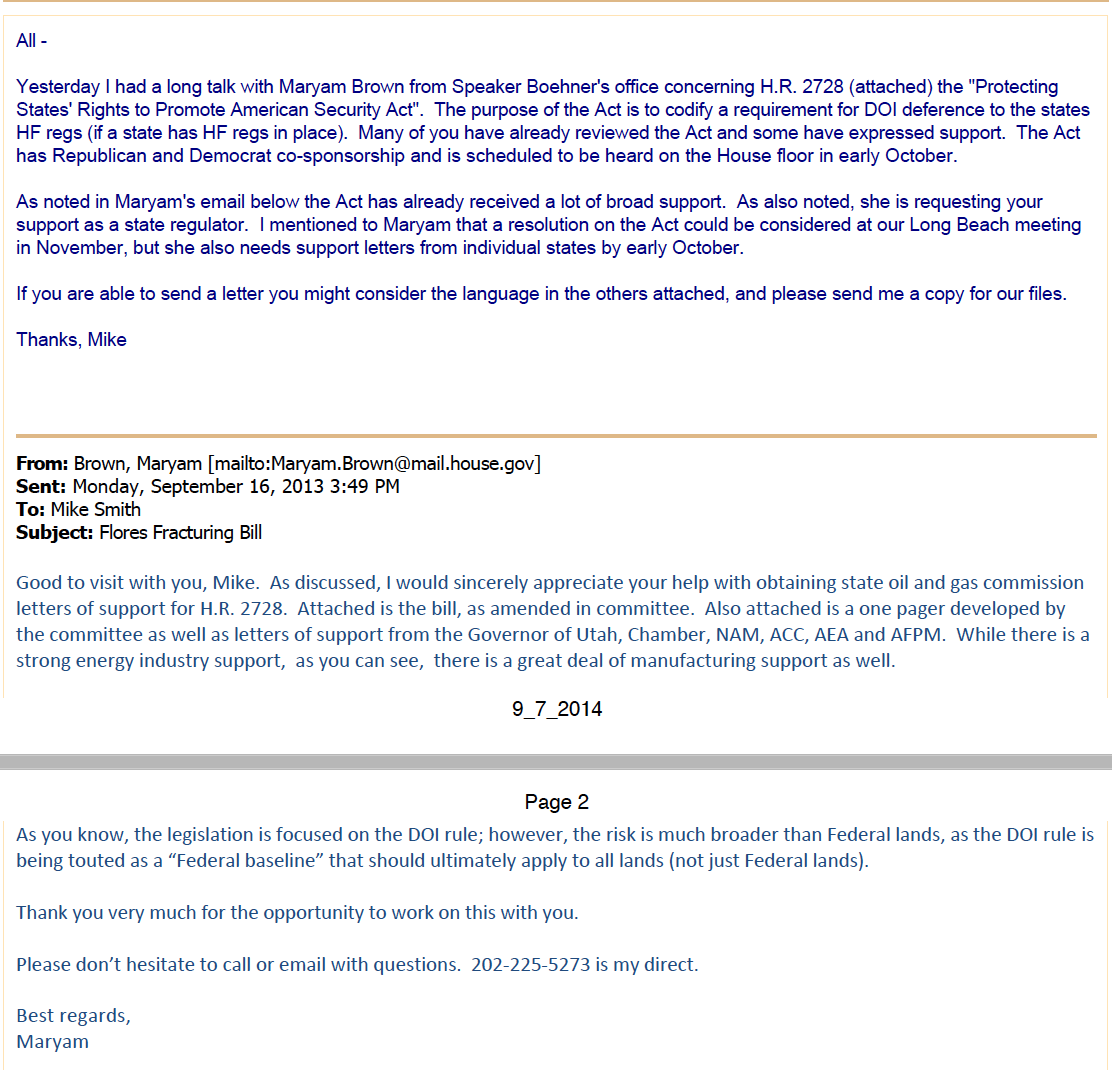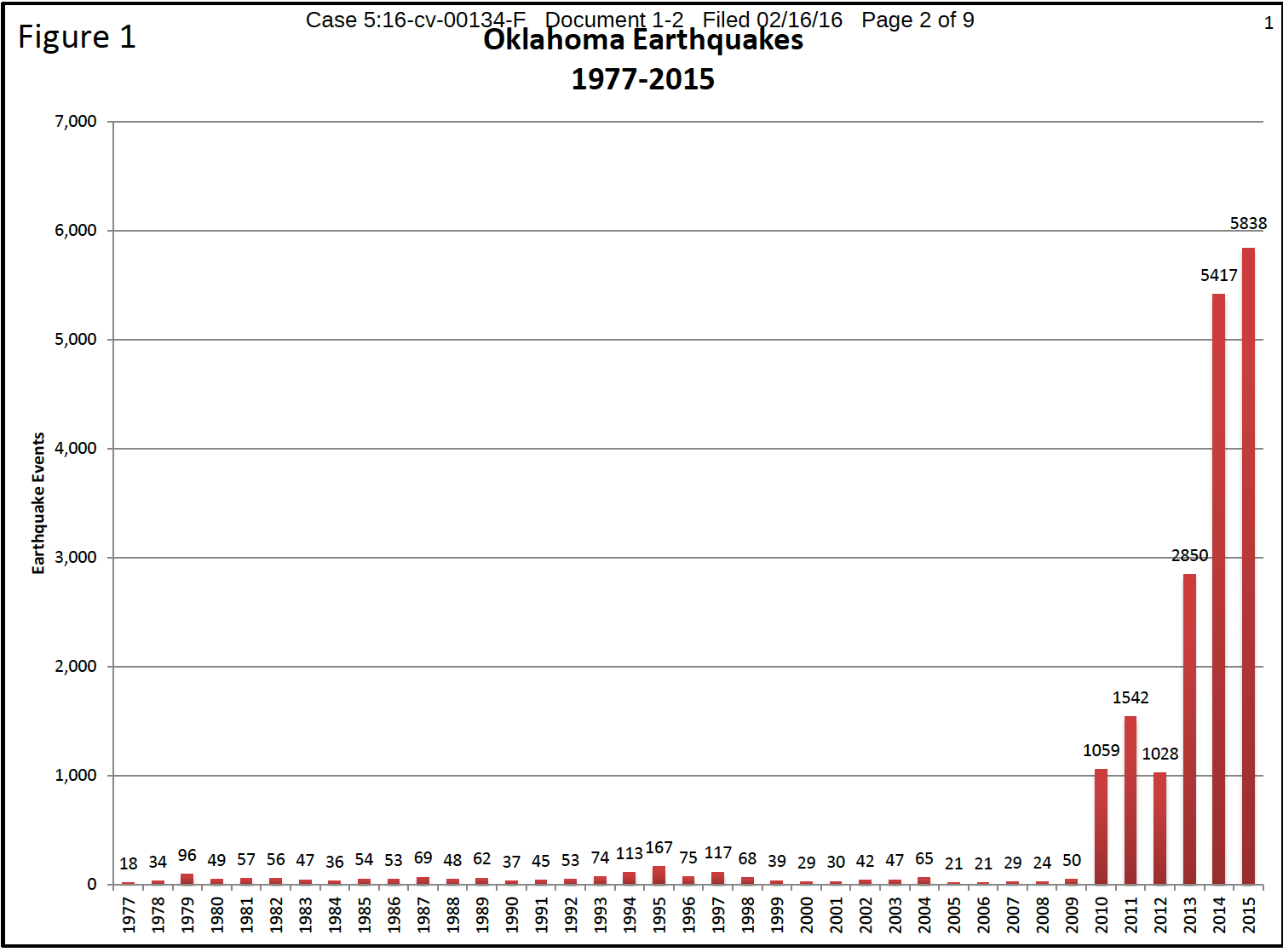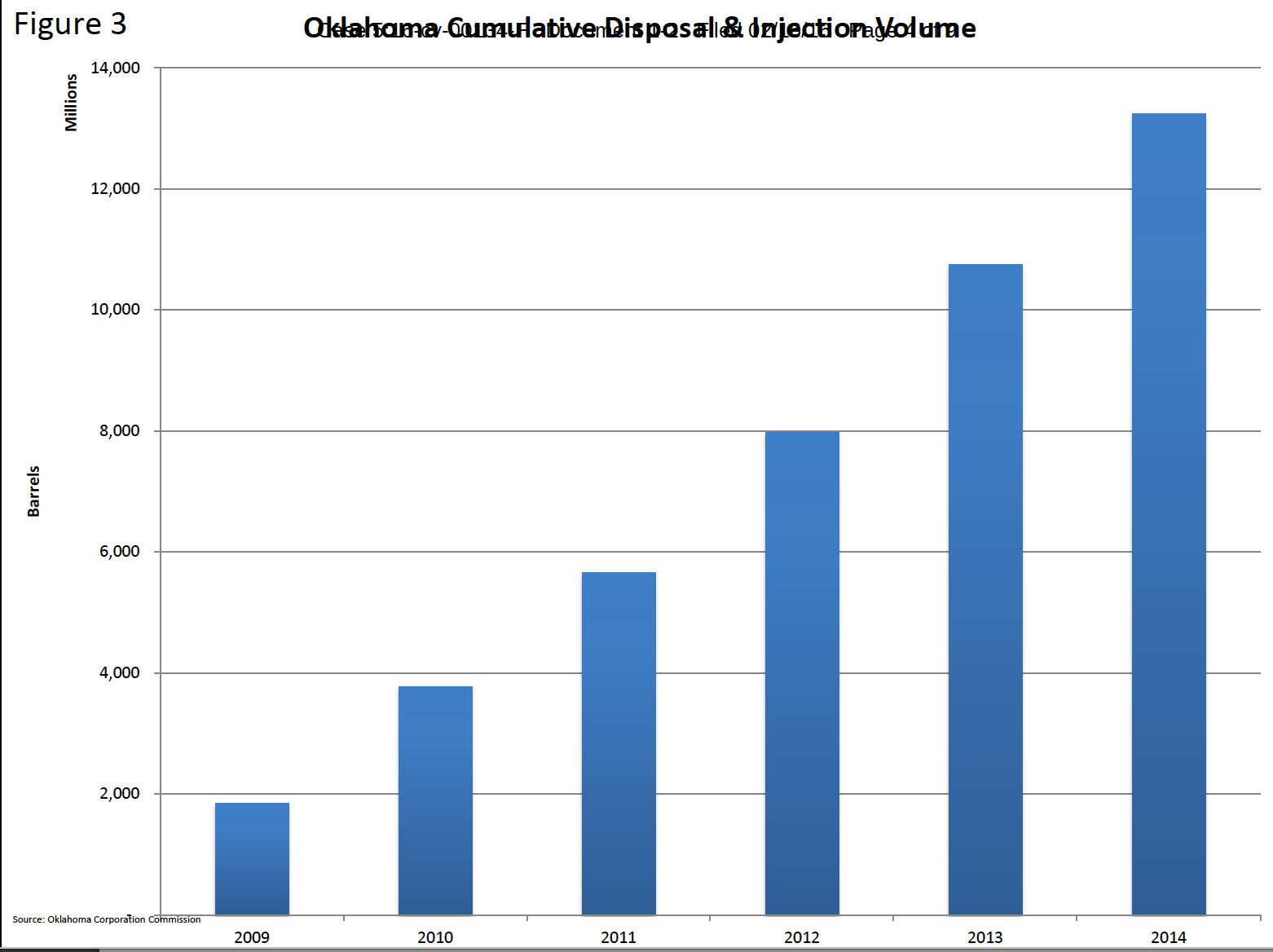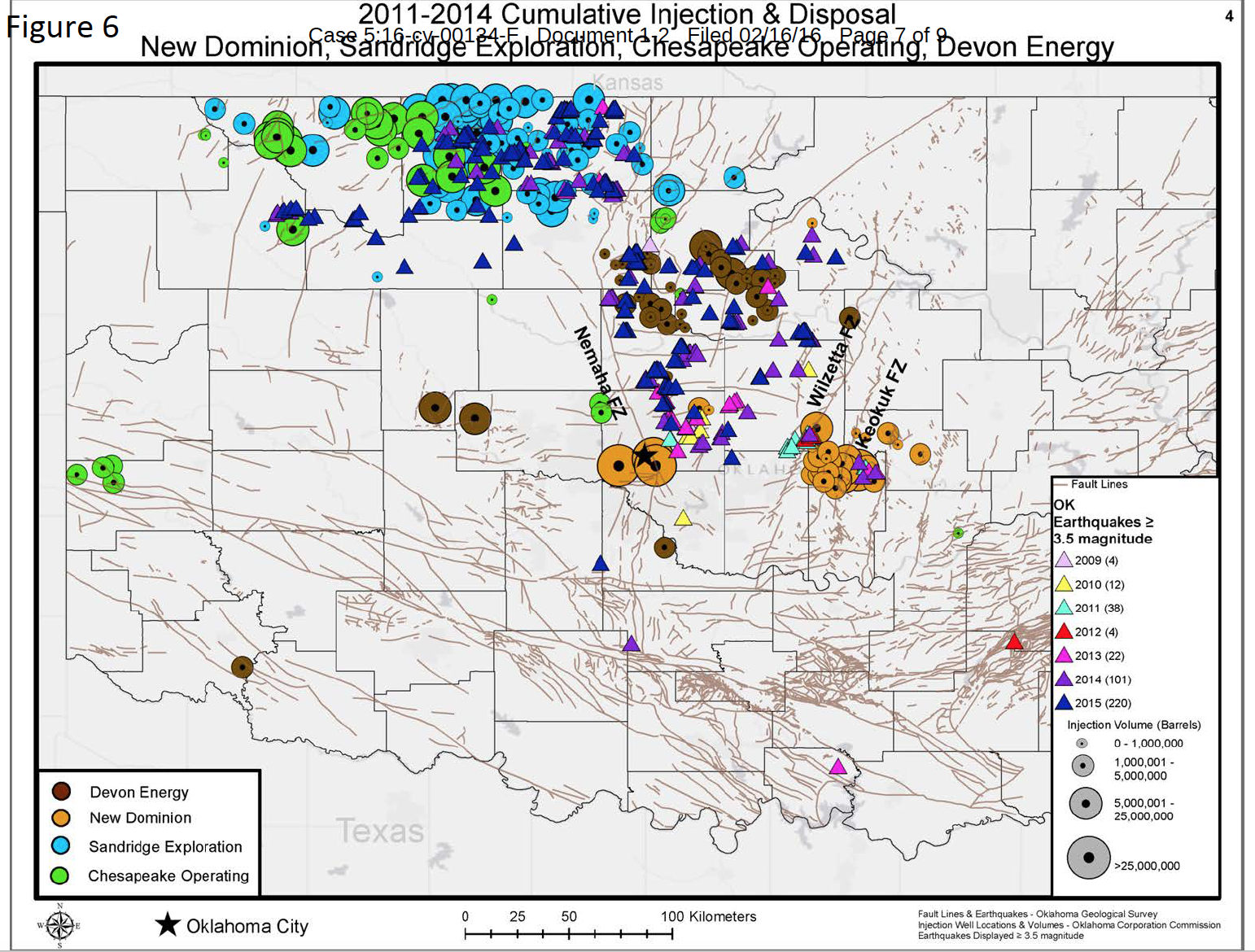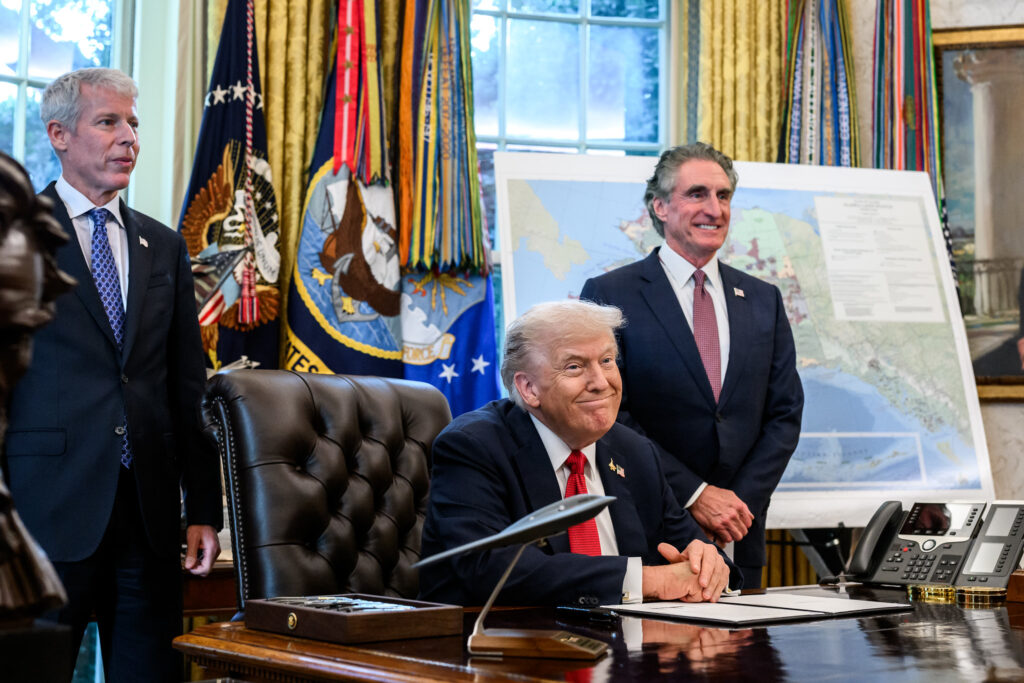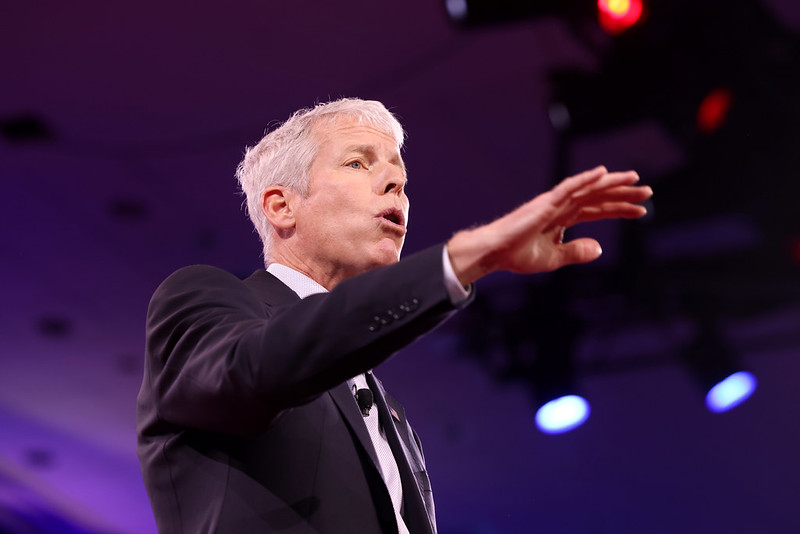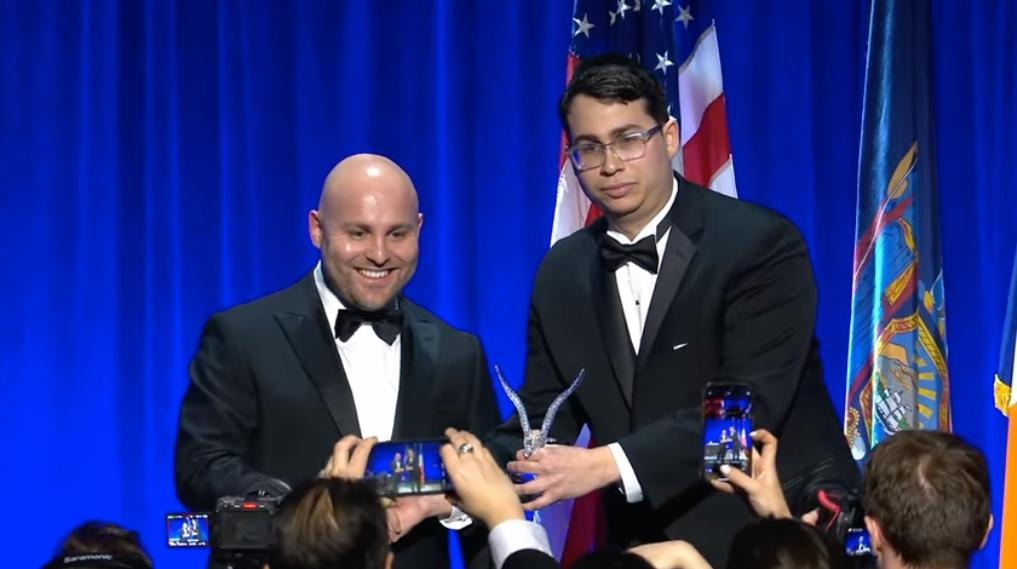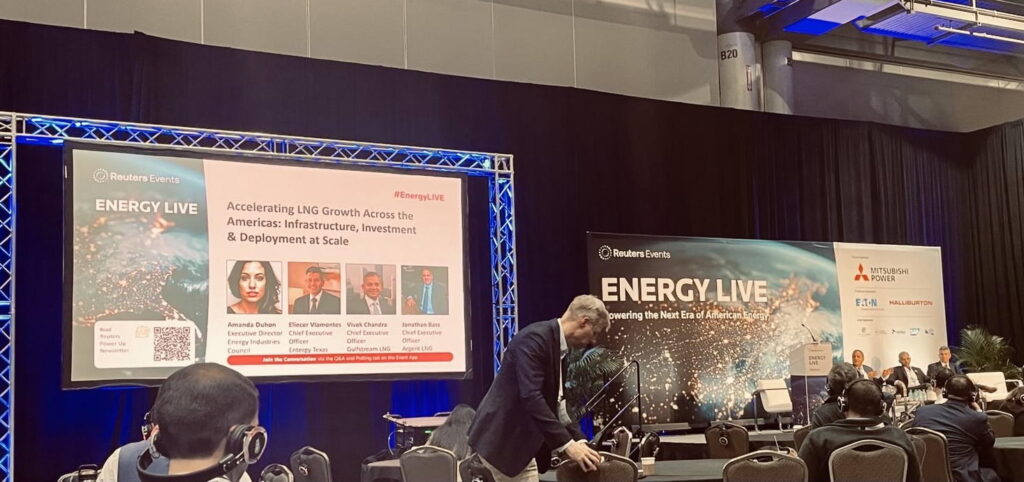Earthquakes caused by injection of shale oil and gas production wastes — and methane leakage from shale gas pipelines — have proliferated in recent years, with both issues well-studied in the scientific literature and grabbing headlines in newspapers nationwide.
Lesser-mentioned, though perhaps at the root of both problems, is a key exemption won by the Interstate Oil and Gas Compact (IOGCC) via a concerted lobbying effort in the 1980’s. That is, classifying oil and gas wastes as something other than “hazardous” or “solid wastes” under Subtitles C and D of the Resource Conservation and Recovery Act (RCRA), thus exempting the industry from U.S. Environmental Protection Agency (EPA) enforcement.
The RCRA exemption has played a front-and-center role in two recent federal lawsuits on both of these issues — the frackquake case just started and the pipeline emissions one recently resulted in a favorable judgment for the industry.
Those cases, Sierra Club v. Chesapeake Operating LLC, Et Al and Northern Illinois Gas Company (a Nicor subsidiary) v. City of Evanston, offer an opportunity for a history lesson. At the center of that history, a DeSmog investigation reveals, is the IOGCC.
IOGCC, a recent InsideClimate News investigation demonstrated using documents obtained by DeSmog and Greenpeace USA, is a constitutionally-authorized interstate compact that more or less has served as a Congress-chartered industry lobbying node since signed into law way back in 1935.
IOGCC‘s RCRA Exemption
Beginning in the late 1970’s, IOGCC entered the fray in the battle to lock in an oil and gas industry RCRA exemption. The earliest IOGCC model resolution dealing with RCRA dates back to one passed in 1979.
As with the Halliburton Loophole and the Energy Policy Act of 2005, in its own newsletter the IOGCC readily admits the prominent role it played in landing the industry a RCRA enforcement loophole in a 2006 retrospective by IOGCC.
In 1980, the ball got rolling on landing this exemption with the Bentsen Amendment, named after the late U.S. Senator Lloyd Bentsen (D-TX). Bentsen ran on the Democratic Party’s presidential ticket in 1988 as Michael Dukakis’ vice president pick.
Located in the Solid Waste Disposal Act Amendments of 1980, the Bentsen Amendment called for the temporary exemption of EPA toxic wastes enforcement of “drilling fluids, produced waters, and other wastes associated with the exploration, development, or production of crude oil or natural gas” under RCRA. EPA was then called on by Congress to study the environmental and public health impacts associated with all of the cradle-to-grave impacts of the oil and gas exploration and production process.
Bentsen, as it would happen, had a staffer who worked on the RCRA issue named Lee Fuller. Fuller would eventually pass through the government-industry revolving door and become a lobbyist for the Independent Petroleum Association of America (IPAA), the creator of the powerful fracking front group Energy in Depth, where he still works today.
“Lee Fuller was Senator Lloyd Bentsen’s staff during the 1979-1980 RCRA development and debate on the provision; more than any other person, he is the architect of the current law,” IPAA proclaimed in a September 2010 IPAA newsletter.
A push to make the temporary exemption a permanent reality ensued over the next eight years and ended with a major industry triumph in 1988.
One of the reasons the push lasted eight years instead of two: it wasn’t supposed to take that long, at least legally. Under the dictates of the statute, EPA had until October 1982 to publish its report.
Failing to abide by its duty to do so, the Alaska Center for the Environment brought a lawsuit in 1985 against the EPA to force it to comply with the Bentsen Amendment. A docket sheet obtained by DeSmog documents that American Petroleum Institute, Independent Oil and Gas Association of West Virginia and West Virginia Oil and Natural Gas Association all served as intervenors for the case.
Image Credit: U.S. District Court for the District of Alaska
“Happy New Year”
DeSmog has also obtained documents from Tarleton State University’s Charles Stenholm collection offering a rare glimpse inside of the eight-year push that took place in the years between passage of the Bentsen Amendment and the eventual settlement of the Alaska Center for the Environment case.
The documents show that U.S. Rep. Stenholm (D-TX) appeared elated to do the bidding of the industry upon hearing of its RCRA concerns, as well exemplified in a 1987 letter exchange he had with the Texas Independent Producers and Royalty Owners Association.
Image Credit: Tarleton State University Charles Stenholm Collection
By the end of 1987, with the RCRA oil and gas wastes exemption more or less locked in, Permian Basin Petroleum Association sent a “Happy New Year” card to Stenholm thanking him for his service to the oil and gas industry.
Image Credit: Tarleton State University Charles Stenholm Collection
“Right Decision”
In 1988, J. Winston Porter — who then served as EPA‘s Assistant Administrator for Solid Waste and Emergency Response and now is a climate change denier who runs his own consultancy — wrote a memo calling for EPA to continue the RCRA exemption as applied to the oil and gas industry. Instead of regulating oil and gas wastes, Porter argued for a collaborative approach between IOGCC and EPA called the Council on Regulatory Needs.
“We were concerned about layering on another level of regulations,” Porter told The Washington Post in 1988. “It was a tough decision but I think we made the right decision.”
An Associated Press story also reported that the oil and gas industry played a key role in maintaining the RCRA exemption and named some of the congressmen who helped make it happen. One of those included, once again, Lloyd Bentsen.
U.S. Sen. Lloyd Bentsen (D-TXPhoto Credit: Wikimedia Commons
“Sens. Lloyd Bentsen, D-Texas, Phil Gramm, R-Texas, and Don Nickles, R-Okla., pressured the agency, as did the Interior and Energy departments and some states,” reported AP. “EPA administrators deny their call was swayed by political pressure.”
Don Nickles, also listed, now works as a lobbyist representing clients such as Anadarko Petroleum and ExxonMobil through his firm Nickles Group.
At the time of the rule-making decision, Don Clay — now Managing Director of Environmental and Regulatory Affairs for Koch Industries — headed up EPA‘s Office of Solid Waste and Emergency Response. Clay started his own firm called Don Clay Associates after leaving his EPA gig, where one of his clients was Koch, thereafter landing the Koch job. Don Nickles also now works as an oil and gas industry lobbyist.
And IOGCC was involved until the 11th hour too, coordinating comments for submission among IOGCC member states’ governors on the RCRA guidelines in April 1988. One of those comments came from then-Oklahoma Governor Henry Bellmon, whose state is now the epicenter of the proliferation of frackquakes.
“I support EPA‘s conclusion that the full RCRA regulations appear unnecessary and impractical at this time, but I would go one step further–it is unnecessary and impractical period,” wrote Bellmon. “EPA‘s decision to recommend no additional regulations does not mean that an industry will go unregulated–rather that it recognizes the abilities of the state agencies to regulate oil and gas activities with proper concern for health and the environment, and the importance of the oil and gas industry to the security of this nation.”
An Earthworks report released in April 2015 details that many states, though, have adopted their own versions of the RCRA exemption, including New York, Ohio, West Virginia and Pennsylvania.
West Virginia’s then-Governor Arch A. Moore was among those to submit a comment to the EPA, citing the adequacy of his state’s regulatory program for oil and gas wastes. Representatives from Ohio and Pennsylvania also weighed in.
Image Credit: Oklahoma Historical Society
RCRA Referendum
A few short years later, a de facto RCRA exemption congressional referendum was held by Congress in 1991 and 1992 on the law at-large’s reauthorization, resulting in the continued oil and gas wastes exemption. IOGCC fought hard to make it so.
“The EPA‘s report to Congress and the regulatory determination two years ago found no necessity to declare these wastes ‘hazardous,’” then IOGCC executive director W. Timothy Dowd testified in front of Congress on September 11, 1991:
Nothing has happened since to change that decision…There is no evidence that these wells…have caused significant environmental damage either to the crops and livestock that flourish around the well locations or to the farm families that live nearby. The IOGCC and its member States support the exemption of E&P wastes from RCRA subtitle C classification…We see no reason for the Congress to impose burdensome and duplicate regulations on top of those that are presently working in the States
Dowd also testified at the 1991 hearing that IOGCC had already passed not one, but nine RCRA-centric model resolutions.
One of those resolutions, passed in March 1991, called for the creation of a “Council on Exploration and Production Wastes,” which would have been a 12-person committee (six from oil and gas regulatory agencies, six from state environmental regulatory agencies) with nine advisory committee members (three from oil and gas regulatory agencies, three from state environmental regulatory agencies and three industry members).
Image Credit: Rutgers School of Law-Newark
Clay also testified at the September 1991 congressional hearing, as did IPAA‘s Denise Bode. IPAA published a white paper in the aftermath of Bode’s testimony, obtained by DeSmog from the Dolph Briscoe Center for American History at The University of Texas at Austin, calling for the RCRA exemption to remain in place,
Further, current IOGCC Executive Director Carl Michael Smith, then vice president of Oklahoma Independent Producers Association, was part of a pro-RCRA exemption lobbying team sent from Oklahoma to lobby Congress and the EPA not to overturn the loophole in 1992, according to a piece published by Oklahoma’s Journal Record. Smith formerly served as Assistant Secretary for Fossil Energy for Department of Energy for the Bush Administration and as a lobbyist for former Secretary of Energy Spencer Abraham’s lobbying firm, The Abraham Group.
RCRA Exemption Efforts Continue
As the 20th century turned into the 21st, IOGCC stayed on top of monitoring and fighting back against efforts to overturn the RCRA exemption it had helped the oil and gas industry carve out.
Ensuring the exemption remained on the books, former IOGCC chairman and Alaska Governor Tony Knowles told those in attendance at the June 2000 IOGCC midyear meeting in Lexington, Kentucky, was a top objective of the compact.
Carol Browner, the EPA Administrator at the time, ensured IOGCC‘s Knowles, former IOGCC chairman and Oklahoma Governor Frank Keating and IOGCC executive director Christine Hansen that the exemption would remain on the books during a private meeting.
“We wanted to make sure she knew the states are doing a great job managing the oil and gas conservation business and that neither she, nor her agency, need concern themselves with already successful programs like the ones we use to manage produced fluids,” the Knowles speech transcript still existing on the Way Back Machine, details.
“I think she agrees that there are more important issues for her agency to address right now. She hears us loud and clear and there should be no barriers for RCRA reauthorization.”
Just about a year later in April 2001, memoranda obtained by DeSmog show, IOGCC expressed internal worry about the contents of the EPA‘s “Brown Book” — the IOGCC-influenced publication that came out back in 1987 — and potential revisions to it. One memo shows that then-IOGCC Washington, DC Representative (lobbyist) Kevin Bliss, which he wrote to then-IOGCC executive director Christine Hansen, set up a meeting with EPA scientists Steve Sounder and Daniel Derkics to make sure it included no substantive policy changes and asked for a review copy and EPA said they could make that happen.
EPA, then run by the Bush Administration and not the Clinton Administration, ensured him no major policy changes loomed, while offering IOGCC a review copy as it had requested.
Dead on Arrival: Overturning RCRA
Some advocates have tried to overturn the RCRA exemption, albeit to date, doing so with little success.
For example in 2010, the Natural Resources Defense Council (NRDC) filed a petition for rulemaking with the EPA, calling for EPA to end the RCRA exemption as applied to oil and gas. NRDC followed that up with a 2012 report documenting the environmental costs of the RCRA exemption.
With little delay and just a couple weeks later, IPAA pledged in its newsletter that it would utilize its resources and political connections like Lee Fuller and others, to fight back.
“While the RCRA Regulatory Determination is not an issue that should be addressed, clearly, the industry must respond to the NRDC threat,” IPAA wrote. “Clearly, American oil and natural gas production faces another compelling challenge by special interests dedicated to preventing new development, seeking to shut down existing operations…However, IPAA is well positioned to respond – and will keep its membership informed as it does and as this issue progresses.”
Fuller told industry publication Natural Gas Intelligence, commenting on the gravity of NRDC‘s petition, that many wells would no longer be “economic” if NRDC‘s push to overturn the RCRA exemption succeeded. NRDC told DeSmog it has yet to hear back from EPA on the status of the petition.
A few years after NRDC filed its petition, U.S. Rep. Matthew Cartwright (D-PA) introduced a bill calling for reversal of the RCRA oil and gas wastes exemption.
Called the CLEANER (Closing Loopholes and Ending Arbitrary and Needless Evasion of Regulations) Act (H.R. 2825), a seven-person IPAA team that included Lee Fuller advocated against the bill’s passage, according to lobbying disclosure forms. The bill made no progress in Congress and sat on the desk of the U.S. House Subcommittee on Environment and the Economy.
On the same day Cartwright introduced H.R. 2825, the U.S. House Subcommittee on Energy and Mineral Resources held a hearing on a different bill that would do the opposite of what the CLEANER Act called for: deregulation of fracking. That bill, Protecting States’ Rights to Promote American Energy Security Act (H.R. 2728), passed in the House and failed to pass nin the U.S. Senate.
At the hearing, Alaska’s IOGCC representative Catherine Foerster testified on behalf of both IOGCC
“The Alaska Oil and Gas Conservation Commission applauds Congressman Flores for introducing this bill and the members of this sub-committee for their interest in considering it,” she said. “The last thing the United States needs right now is duplicative regulation of an already stringently regulated process, unless, of course, we need increased federal spending and bureaucracy; delays in providing jobs, revenue, and affordable domestic energy; confusion among operators and regulators; and one-sizefits-all regulations that are ignorant to regional differences.”
Beyond testifying on behalf of H.R. 2728 at the congressional hearing, IOGCC played a central role in pushing that bill as a shadow non-registered lobbying squadron — alongside registered lobbying interests such as IPAA, Devon Energy, Chevron, Devon Energy, Chesapeake Energy, API, ANGA, ExxonMobil and others — behind the scenes.
E-mails obtained via the North Dakota Industrial Commission expose that IOGCC coordinated with the office of then-U.S. House Majority Leader John Boehner (R-OH) to gather signatures from state-level regulatory commissions in support of H.R. 2728’s passage.
Image Credit: North Dakota Industrial Commission
Maryam Brown, who wrote the email to IOGCC Executive Director Carl Michael Smith that he then forwarded onto his state-level IOGCC oil and gas regulatory agency colleagues, formerly worked as a public policy manager for ConocoPhillips according to her LinkedIn page.
Cartwright gave the CLEANER Act a second try in December 2015, this time in the form of H.R. 4215. Mirroring its H.R. 2825 predecessor, it was dead on arrival and sat on the desk of the Subcommittee on Environment and the Economy.
Back to the Future: RCRA, Frackquakes, Methane Leakage
The history of RCRA and its exempt status as applied to the oil and gas industry, brings us back to the future with the City of Evanston and Sierra Club cases.
As the ruling laid out in City of Evanston, “Methane gas was first detected in and around James Park [near a Nicor pipeline] in Evanston, Illinois, in 2012. If this methane were to reach concentrations at or exceeding the gas’s ‘lower explosive limit,’ it could combust when exposed to an ignition source.”
James Park is located near both an elementary school and a senior center and methane is a greenhouse gas more potent in terms of its global warming potential than carbon dioxide. Yet, even with those facts on the ground, the Court ruled that the RCRA exemption trumps all else.
“Congress has authorized the EPA to oversee the implementation of RCRA and to issue regulations with the force of law in furtherance of this effort,” wrote the Court. “And the EPA has concluded…that uncontained gases do not fall within RCRA‘s definition of solid waste.”
It appears Nicor, and thus now the industry at-large due to the legal precedent City of Evanston sets, also got a bit of help from the Obama White House’s industry-friendly Office of Information and Regulatory Affairs along the way. OIRA concluded, according to a November 2011 document, that “EPA interpretation of the term ‘contained gaseous material’ demonstrates that RCRA only applies to ‘contained’ gases, to the exclusion of ‘uncontained’ gases.”
John Z. Lee cited this OIRA interpretation in his ruling. It’s a simple conclusion from there, given the legal and regulatory state-of-play, wrote Judge Lee.
“Because the Court concludes that methane gas does not meet the definition of RCRA solid waste,” he wrote, “Evanston cannot base a RCRA claim on the release of methane gas from natural gas pipelines.”
The methane storage and leakage issue is not just a thing of the past, however, for IOGCC. In the wake of the California methane leakage crisis in California, IOGCC has created a natural gas storage working group.
Gas storage impacts are also exempt from Safe Drinking Water Act enforcement, a lesser known provision within the “Halliburton Loophole” that IOGCC played a central role in inserting into the Energy Policy Act of 2005.
Meanwhile in the Sierra Club case, the plaintiffs utilized RCRA to say that Chesapeake and other companies have violated the law, calling on the U.S. District Court for the Western District of Oklahoma to set a new legal precedent: RCRA as applied to disposal of an oil and gas waste injection, which is causing rampant earthquakes in the state.
In exhibits cited as part of the complaint, Sierra Club points to the upswing in earthquakes in Oklahoma in recent years, juxtaposing this with figures depicting the accompanying upswing in levels of waste injection volume. As an exhibited map shows, the ‘quakes have increased alongside oil and gas waste injection levels increasing.
Image Credits: U.S. District Court for the Western District of Oklahoma
Yet even armed with damning facts and scientific truths on their side, by definition and as the history has shown, an oil and gas-related RCRA victory for Sierra Club in this case would prove unprecedented.
NEXT: IOGCC, as documented in part one, worked hard to win the fracking industry an exemption to the Safe Drinking Water Act starting in the 1990’s. Part three will demonstrate how, incorporating documents obtained from historical archives and records requests, the roots of this fight are nearly as old as the Act itself.
Photo Credit: Steve Horn, DeSmog
Subscribe to our newsletter
Stay up to date with DeSmog news and alerts


